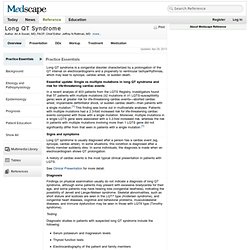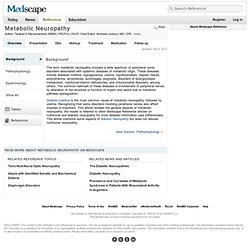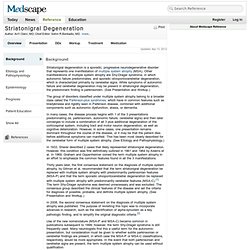

Long QT Syndrome: eMedicine Cardiology. The QT interval represents the duration of activation and recovery of the ventricular myocardium.

Prolonged recovery from electrical excitation increases the likelihood of dispersing refractoriness, when some parts of myocardium might be refractory to subsequent depolarization. From a physiologic standpoint, dispersion occurs with repolarization between 3 layers of the heart, and the repolarization phase tends to be prolonged in the mid myocardium. This is why the T wave is normally wide and the interval from Tpeak to Tend (Tp-e) represents the transmural dispersion of repolarization (TDR).
In long QT syndrome (LQTS), TDR increases and creates a functional substrate for transmural reentry. Torsade de pointes In LQTS, QT prolongation can lead to polymorphic ventricular tachycardia, or torsade de pointes, which itself may lead to ventricular fibrillation and sudden cardiac death. Genetics LQT4 gene The LQT4 gene (ANK2 or ANKB) encodes for the ankyrin-B. Alpha-1-syntrophic gene mutation Stimuli. Metabolic Neuropathy: eMedicine Neurology.
Little is known about the mechanisms underlying metabolic peripheral neuropathy.

As stated above, metabolic impairment causes demyelination or axonal degeneration. Diabetic polyneuropathy Studies in rats have demonstrated involvement of the polyol pathway. Myoinositol and taurine depletion have been associated with reduced Na+/K+ -ATPase activity and decreased nerve conduction velocities (NCVs), all of which are corrected by aldose reductase inhibitors in rat studies. Recent studies have suggested that aldose reductase inhibitors may also improve NCVs and protect small sensory fibers from degeneration. Sural nerve biopsies from patients with diabetes have demonstrated changes suggestive of microvascular insufficiency, including membrane basement thickening, endothelial cell proliferation, and vessel occlusions. Another mechanism in diabetic neuropathy is impaired neurotrophic support. A glycoprotein called laminin promotes neurite extension in cultured neurons. Schwartz-Jampel Syndrome: eMedicine Neurology. Prior to the discovery of the specific gene defect in SJS, the syndrome’s similarity to myotonic disorders provoked speculation that a muscle ion channel abnormality or a muscle enzyme defect might underlie this condition.

The fact that a defect exists in the gene for perlecan, a heparin sulfate proteoglycan that is the major proteoglycan of basement membranes and is present in cartilage, supports the general concept of a membrane abnormality and the presence of dysmorphic features. However, precise knowledge as to why abnormal electrical discharges occur is still lacking.
Perhaps the perlecan abnormality produces secondary membrane channel abnormalities. In addition, how this basement membrane defect actually causes the skeletal and other morphologic problems is not understood.
Mitral valve prolapse. Hyperhidrosis: eMedicine Dermatology. Postural Orthostatic Tachycardia Syndrome. Syncope. Posttraumatic Syringomyelia: eMedicine Physical Medicine and Reh. Spinal Cord Injury. Prion-Related Diseases: eMedicine Neurology. Uremic Neuropathy: eMedicine Neurology. Striatonigral Degeneration: eMedicine Neurology. Striatonigral degeneration is a sporadic, progressive neurodegenerative disorder that represents one manifestation of multiple system atrophy (MSA).

Other manifestations of multiple system atrophy are Shy-Drager syndrome, in which autonomic failure predominates, and sporadic olivopontocerebellar degeneration, which is characterized primarily by cerebellar signs. While symptoms of autonomic failure and cerebellar degeneration may be present in striatonigral degeneration, the predominant finding is parkinsonism. (See Presentation and Workup.) The group of disorders classified under multiple system atrophy belong to a broader class called the Parkinson-plus syndromes, which have in common features such as bradykinesia and rigidity seen in Parkinson disease, combined with additional components such as autonomic dysfunction, ataxia, or dementia.
In 1933, Sherer described 2 cases that likely represented striatonigral degeneration. Viral Encephalitis: eMedicine Neurology. HSE is the most common form of encephalitis in the United States (see Herpes Simplex Encephalitis).

Human herpesvirus (HHV)-6, the causative agent of exanthema subitum, has been associated with a wide spectrum of neurologic complications, including viral (focal) encephalitis.
Inguinal Hernia. Synesthesia. Restless Legs Syndrome (RLS) Generalized Anxiety Disorder. TMJ disorders: MedlinePlus Medical Encyclopedia. Temporomandibular joint and muscle disorders (TMJ disorders) are problems or symptoms of the chewing muscles and joints that connect your lower jaw to your skull.

See also: Facial pain Causes There are two matching temporomandibular joints -- one on each side of your head, located just in front of your ears. The abbreviation "TMJ" literally refers to the joint but is often used to mean any disorders or symptoms of this region. Many TMJ-related symptoms are caused by the effects of physical stress on the structures around the joint. Cartilage disk at the jointMuscles of the jaw, face, and neckNearby ligaments, blood vessels, and nervesTeeth For many people with temporomandibular joint disorders, the cause is unknown. A bad bite or orthodontic bracesStress and tooth grinding. Poor posture can also be an important factor in TMJ symptoms. Other factors that might make TMJ symptoms worse are stress, poor diet, and lack of sleep.
Premenstrual dysphoric disorder: MedlinePlus Medical Encyclopedi. Premenstrual dysphoric disorder (PMDD) is a condition in which a woman has severe depression symptoms, irritability, and tension before menstruation.

The symptoms of PMDD are more severe than those seen with premenstrual syndrome (PMS). PMS refers to a wide range of physical or emotional symptoms that typically occur about 5-11 days before a woman starts her monthly menstrual cycle. The symptoms usually stop when, or shortly after, her period begins. Causes The causes of PMS and PMDD have not been found. Hormone changes that occur during a woman's menstrual cycle may play a role. PMDD affects between 3% and 8% of women during the years when they are having menstrual periods.